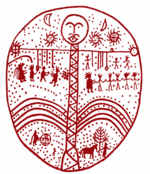Similar topics
"Shamans and Archaeology" -
Page 1 of 1
 "Shamans and Archaeology" -
"Shamans and Archaeology" -
From Archaeology.about.com:
Shamans and Archaeology
Monday April 6, 2009
What are the archaeological signatures of shamans? An interesting paper by Christine VanPool appearing in the Journal of Anthropological Archaeology in the nearish future gives us a framework for answering that question.
[...]In brief, though, the way VanPool sees it, shamans and priests are two ends of a continuum of religious specialists.
What are Religious Specialists?
Religious specialists are those people in a given society who have a connection to the deities who control things humans cannot. Religious specialists are classed by dry-as-dust archaeologists as "craft specialists", and the presence of craft specialists—people with assigned part time or full time jobs including crop tending and child care and pot making and flint knapping and tending to the religious needs of a society—is one of those characteristics of complex societies that anthropologists (and archaeologists) use to discuss how people organize themselves.
Shamans, associated with hunter-gatherer societies, may be part-time specialists, with a practice that primarily focuses on the problems of the individual. Shamans use private spaces for connecting with the underworld and actually become spiritual creatures themselves, using altered states of consciousness to connect to the other world.
Priests, on the other hand, are generally associated with agricultural societies. They have a more formalized role, and work full time at their craft; they work for the goals of the entire society. Priests follow a liturgical text and calendar, and use public spaces for publicly-attended communication with the underworld. Priests are representatives of the gods, not the gods themselves, and they don't typically use altered states of consciousness to speak to them.
VanPool points out that the two categories are created by archaeologists and anthropologists, and are not mutually exclusive in real-life applications—you can have both types of specialists in a given society. Some societies have shaman-priests who combine traits of both. Further, many native religions were greatly impacted by colonization and missionaries, creating a great loss of diversity; but colonization, agricultural complexity and even urbanization does not necessarily entail a complete shift away from shamanism.
Identifying Religious Specialists
Typically, archaeologists have used the presence of a ritual-specific artifact or a rock art drawing of an anthropomorphic creature with animal characteristics to tentatively suggest the presence of a shaman within a given society. VanPool makes a cogent argument that by now anthropologists have identified a suite of cross-cultural traits that can be identified archaeologically and thus used to confidently argue for shamanism as a practice at an archaeological site or set of sites.
These traits include evidence of the use of hallucinogens (seeds, plant residues, or identifying the specific chemicals) to achieve altered states of consciousness and entopic imagery—grids, stars, spirals—on rock art or on ceramic vessels; evidence of pilgrimages or pilgrimage routes; anthropomorphic images; animal fetishes; crystals; drums and rattles; incense; temporary altars; effigy pipes, and the like. It is only with a combination of traits, says VanPool, that we can confidently hypothesize a shamanistic element in our archaeological past.
Further Reading
VanPool, Christine. in press. The signs of the sacred: Identifying shamans using archaeological evidence. Journal of Anthropological Archaeology.

ankh_f_n_khonsu- Number of posts : 545
Registration date : 2008-09-15
 Similar topics
Similar topics» "Peru's Shamans Send US Election Vibes"
» "Dr. Steven Greer presents 'Contact & Disclosure: The Final Sequence'" -
» "Scientists use computer science to crack Indus Valley script" -
» "Dr. Steven Greer presents 'Contact & Disclosure: The Final Sequence'" -
» "Scientists use computer science to crack Indus Valley script" -
Page 1 of 1
Permissions in this forum:
You cannot reply to topics in this forum
